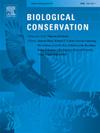商业野生收获的植物只是普通的吗?法国的性状、采收模式及其保护意义
IF 4.4
1区 环境科学与生态学
Q1 BIODIVERSITY CONSERVATION
引用次数: 0
摘要
野生植物的收获在日常生活中起着重要作用,有超过40,000种植物的用途得到了充分的记录。然而,其对野生收获植物(WHP)种群的生态影响往往被忽视。本研究对法国的商业野生采伐进行了全面评估,探讨了推动这种做法的因素,并确定了有关保护问题的知识差距。我们分析了法国大都市区和科西嘉岛的692种商业收获的野生植物,占全国维管植物区系的12%。我们的评估考虑了它们的系统发育、分布、收获部位、用途、生活形式、Grime的企业社会责任战略、保护状况和监管措施。我们的研究结果突出了WHP的分类多样性,包括110个科(占法国维管植物科的60%)和431个属(占所有属的33%)。分析显示,系统发育对WHP选择的影响较弱,表明这种选择有其他因素。WHP在地理上分布广泛,在阿尔卑斯山和法国南部的多样性最高。在生态学上,它们反映了法国植物群在生命形式和CSR策略方面的广泛特征。这些结果支持了主要由物种可用性驱动的“收获综合征”的概念。收获WHP可主要用于药用(占WHP物种的37%)、食用(20%)和工艺(14%)目的,60%的情况下可能采用破坏性方法。保护分析表明,与整个植物区系相比,野生植物区系面临的风险通常较小,其中91%被世界自然保护联盟列为最不受关注的植物区系,尽管需要更多的地方保护评估来解决特定区域的威胁。本文章由计算机程序翻译,如有差异,请以英文原文为准。
Are commercial wild-harvested plants just ordinary? Traits, harvesting patterns and conservation implications in France
Wild plant harvesting plays a significant role in daily life, with over 40,000 species having well-documented uses. However, its ecological impacts on wild-harvested plant (WHP) populations are often overlooked. This study provides a comprehensive assessment of commercial wild harvesting in France, exploring the factors that drive this practice and identifying knowledge gaps regarding conservation concerns. We analysed 692 commercially harvested wild plant species in Metropolitan France and Corsica, representing 12 % of the national vascular flora. Our assessment considered their phylogeny, distribution, harvested parts, uses, life forms, Grime's CSR strategies, conservation status, and regulatory measures.
Our findings highlight the taxonomic diversity of WHP, spanning 110 families (60 % of French vascular plant families) and 431 genera (33 % of all genera). Analyses reveal a weak phylogenetic influence on WHP selection, suggesting additional contributing factors to this selection. WHP are geographically widespread, with the highest diversity in the Alps and southern France. Ecologically, they reflect the broad characteristics of French flora in terms of life forms and CSR strategies. These results support the concept of a ‘harvesting syndrome’ driven mostly by species availability.
WHP can be harvested primarily for medicinal (37 % of WHP species), food (20 %), and craft (14 %) purposes, with destructive methods potentially used in 60 % of cases. Conservation analysis indicates that WHP are generally less at risk than the total flora, with 91 % classified as Least Concern by the IUCN, though more local conservation assessments are needed to address region-specific threats.
求助全文
通过发布文献求助,成功后即可免费获取论文全文。
去求助
来源期刊

Biological Conservation
环境科学-环境科学
CiteScore
10.20
自引率
3.40%
发文量
295
审稿时长
61 days
期刊介绍:
Biological Conservation is an international leading journal in the discipline of conservation biology. The journal publishes articles spanning a diverse range of fields that contribute to the biological, sociological, and economic dimensions of conservation and natural resource management. The primary aim of Biological Conservation is the publication of high-quality papers that advance the science and practice of conservation, or which demonstrate the application of conservation principles for natural resource management and policy. Therefore it will be of interest to a broad international readership.
 求助内容:
求助内容: 应助结果提醒方式:
应助结果提醒方式:


